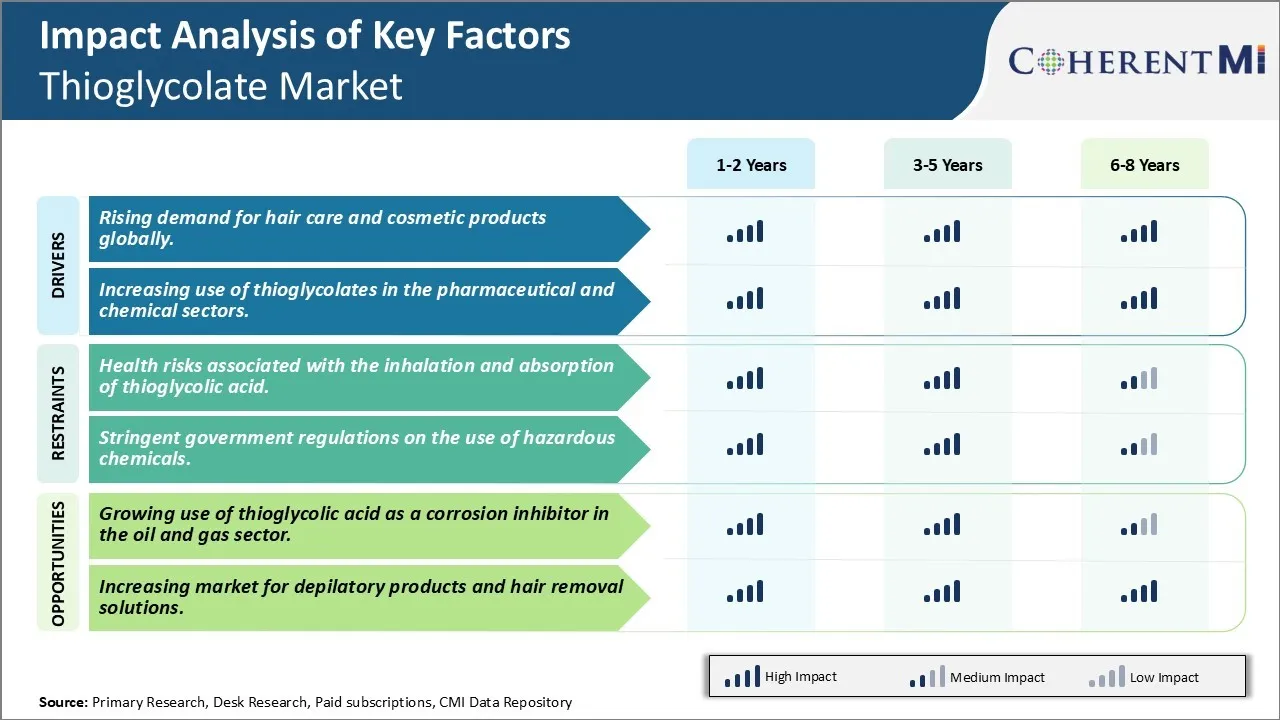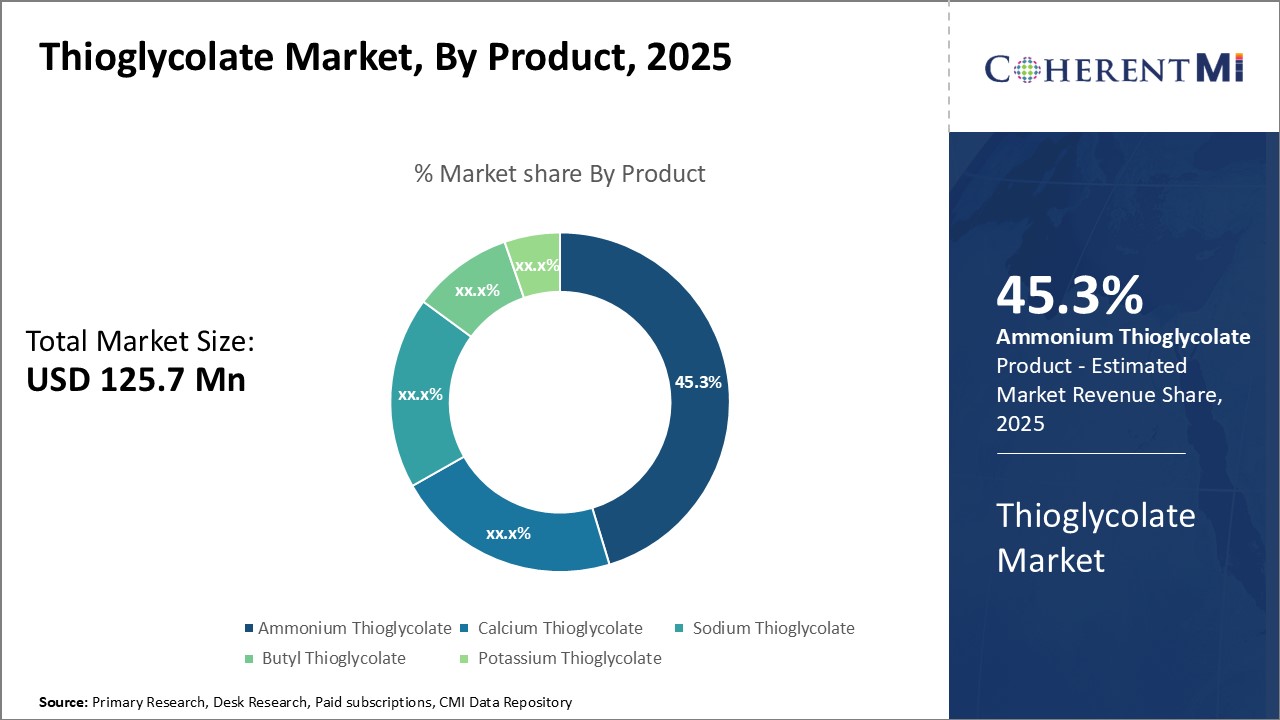Thioglycolate Market Size - Analysis
The Global Thioglycolate Market is estimated to be valued at USD 125.7 Mn in 2025 and is expected to reach USD 182.9 Mn by 2032, growing at a compound annual growth rate (CAGR) of 5.5% from 2025 to 2032.
Market Size in USD Mn
CAGR5.5%
| Study Period | 2025-2032 |
| Base Year of Estimation | 2024 |
| CAGR | 5.5% |
| Market Concentration | High |
| Major Players | Triveni Chemicals, Haihang Industry Co. Ltd., Neostar United Industrial Co. Ltd., Alpha Chemika, American International Chemical Inc. and Among Others |
please let us know !
Thioglycolate Market Trends
The demand for hair care and cosmetic products has seen a significant rise globally over the past decade. Changing lifestyles, increasing disposable incomes and growing focus on personal beauty and appearances have all contributed to this rise in demand from consumers worldwide. Hair care products especially shampoos, conditioners and hair styling products have become a daily essential for both men and women across age groups in many countries now. Their usage is no more confined just for special occasions or weekends.
Similarly, cosmetic products ranging from skin lightening creams, facial cleansers, moisturizers, shaving products, deodorants, fragrances are being adopted at an accelerated pace. More women participating in formal education and employment means greater attention to grooming and this catalyzes the sale of such personal care items. Growing media exposure through social media and digital platforms has further ignited novelty seeking and brand conscious tendencies among youth. Companies leverage this by launching new hair colors, nail paints and makeup ranges compelling users to try different looks regularly and keep repurchasing. This consequently stokes the demand for thioglycolate which is widely used as a reducing and stabilizing agent in cosmetic formulations.
Besides cosmetic applications, thioglycolate also finds extensive use as a processing aid and intermediate in the pharmaceutical and chemicals industries. It acts as a reducing and stabilizing agent for active pharmaceutical ingredients as well as helps in synthesizing vital chemicals.
Apart from pharmaceutical, thioglycolate derivatives play a crucial role as chemical intermediates in various industries including plastics, resins, rubber, leather, paints & coatings, petrochemicals. It is used in synthesis of polymers, plasticizers, emulsifiers and specialist chemicals. Many countries are rapidly industrializing and their manufacturing sectors are fast expanding. China, India, Southeast Asia, Middle East, South America are experiencing double digit growth in key industry verticals annually.

One of the major challenges faced by the thioglycolate market is the various health risks posed by thioglycolic acid to workers who are exposed to it on a regular basis. Thioglycolic acid is a colorless liquid with a strong unpleasant smell and chemicals containing this acid are widely used in permanents, relaxers or straighteners in hair care products. However, inhalation or absorption of thioglycolic acid vapors can cause serious health issues. Short term exposure through inhalation can cause respiratory tract irritation, nausea, vomiting and headaches. Long term or repeated exposure may lead to more severe effects like asthma, bronchitis and dermatitis. The harmful effects are more pronounced among those working in factories producing chemicals containing thioglycolic acid. Strict safety guidelines and protective measures need to be followed while handling these chemicals but non-compliance remains an issue in some parts of the world. This poses an occupational hazard and makes it difficult to attract workforce, thereby affecting production levels. While innovation in product formulations can help reduce risks, complete elimination may not be feasible. Improving awareness and ensuring worker safety should remain a priority to address this challenge for the sustained growth of the thioglycolate market.
Market Opportunity - Growing Use of Thioglycolic Acid as a Corrosion Inhibitor in the Oil and Gas Sector.
Key winning strategies adopted by key players of Thioglycolate Market
Strategic partnerships and acquisitions: Many players have grown in the thioglycolate market through strategic partnerships and acquisitions that expanded their production capabilities and product portfolios. For example, in 2017, Bruno Bock acquired High Point Chemical and expanded its thioglycolate manufacturing plant in the US. This strengthened Bruno Bock's presence in North America.
Target emerging markets: Players shifted focus to emerging regions with rising demand like Asia Pacific and Latin America. Arkema partnered with local distributors in China during 2015-18 to supply thioglycolates used in oilfield applications. Asia Pacific now contributes over 35% of Arkema's thioglycolate revenues.
These strategies of partnerships, R&D investments, targeting growth regions and portfolio diversification have helped leading players strengthen their position in the thioglycolate market over the last decade. Data shows companies adopting these demand-driven strategies have consistently grown revenues faster than others.
Segmental Analysis of Thioglycolate Market

Insights, By Product, Ammonium Thioglycolate is Projected to Contribute High in the Coming Years
As a sulfur-based chemical, ammonium thioglycolate plays a critical role in the production of organic pesticides that effectively control insects, mites and fungal infections in crops. Many farmers across major agricultural regions have started incorporating organic sprays containing this compound into their integrated pest management strategies. The rising need for sustainable agriculture techniques is expected to further boost demand for ammonium thioglycolate from the pesticide manufacturing industry. With more governments offering subsidies and incentives for adopting organic methods, the share of this segment is likely to grow at a steady pace over the coming years.
Additional Insights of Thioglycolate Market
The thioglycolate market is expected to witness moderate growth due to the increasing demand from the cosmetic and pharmaceutical industries. The North American market leads the segment, driven by stringent regulatory frameworks that promote sustainable and safe personal care products. The rising disposable income and awareness in emerging markets such as Asia-Pacific are expected to further drive demand. However, health risks and regulatory restrictions may pose challenges, especially concerning the corrosive nature of thioglycolic acid. The market is seeing growing adoption in hair removal and haircare products, along with expanding use in pharmaceuticals as a stabilizer. Companies are continuously innovating to create safer and more efficient formulations to capture consumer trust.
Competitive overview of Thioglycolate Market
The major players operating in the Thioglycolate Market include Triveni Chemicals, Haihang Industry Co. Ltd., Neostar United Industrial Co. Ltd., Alpha Chemika, American International Chemical Inc., ICC Chemical Corporation, Alfa Aesar, CellMark Chemicals, Advanced Technology & Industrial Co. Ltd., AN Pharma Tech Co. Ltd., Bruno Bock Chemische Fabrik GmbH & Co. KG, Arkema and Kumar Organic Products Limited.
Thioglycolate Market Leaders
- Triveni Chemicals
- Haihang Industry Co. Ltd.
- Neostar United Industrial Co. Ltd.
- Alpha Chemika
- American International Chemical Inc.
Thioglycolate Market - Competitive Rivalry

Thioglycolate Market
(Dominated by major players)
(Highly competitive with lots of players.)
Recent Developments in Thioglycolate Market
- In March 2024, Acorelle launched a new natural depilatory cream, effective in just 3 minutes, aimed at reducing hair without pain.
- In June 2023 L’Oréal invested in US biotech company Debut to enhance its ingredient portfolio with a focus on sustainability. This strategic partnership is expected to accelerate the introduction of sustainable beauty products.
- In August 2022, UrbanGabru, a men’s grooming brand, launched India's first painless hair removal spray for men, with a de-tan property to moisturize the skin.
Thioglycolate Market Segmentation
- By Product
- Ammonium Thioglycolate
- Calcium Thioglycolate
- Sodium Thioglycolate
- Butyl Thioglycolate
- Potassium Thioglycolate

Would you like to explore the option of buying individual sections of this report?
Vidyesh Swar is a seasoned Consultant with a diverse background in market research and business consulting. With over 6 years of experience, Vidyesh has established a strong reputation for his proficiency in market estimations, supplier landscape analysis, and market share assessments for tailored research solution. Using his deep industry knowledge and analytical skills, he provides valuable insights and strategic recommendations, enabling clients to make informed decisions and navigate complex business landscapes.
Frequently Asked Questions :
How Big is the Thioglycolate Market?
The Global Thioglycolate Market is estimated to be valued at USD 125.7 Mn in 2025 and is expected to reach USD 182.9 Mn by 2032.
What will be the CAGR of the Thioglycolate Market?
The CAGR of the Thioglycolate Market is projected to be 5.3% from 2024 to 2031.
What are the key factors hampering the growth of the Thioglycolate Market?
The health risks associated with the inhalation and absorption of thioglycolic acid and stringent government regulations on the use of hazardous chemicals are the major factors hampering the growth of the Thioglycolate Market.
What are the major factors driving the Thioglycolate Market growth?
The rising demand for hair care and cosmetic products globally and increasing use of thioglycolates in the pharmaceutical and chemical sectors are the major factors driving the Thioglycolate Market.
Which is the leading Product in the Thioglycolate Market?
Ammonium Thioglycolate is the leading Product segment.
Which are the major players operating in the Thioglycolate Market?
Triveni Chemicals, Haihang Industry Co. Ltd., Neostar United Industrial Co. Ltd., Alpha Chemika, American International Chemical Inc., ICC Chemical Corporation, Alfa Aesar, CellMark Chemicals, Advanced Technology & Industrial Co. Ltd., AN Pharma Tech Co. Ltd., Bruno Bock Chemische Fabrik GmbH & Co. KG, Arkema, Kumar Organic Products Limited are the major players.